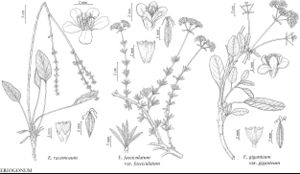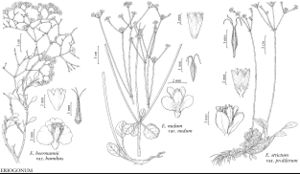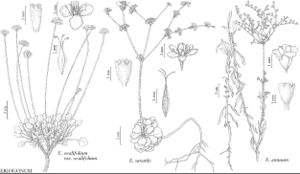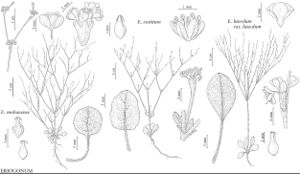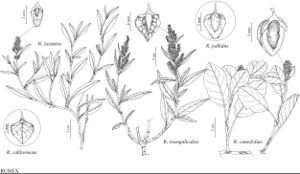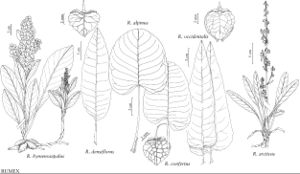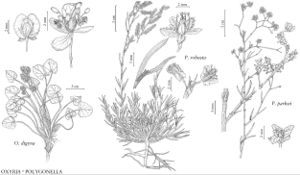Polygonaceae
Trees, shrubs, vines, or herbs, perennial, biennial, or annual, homophyllous (heterophyllous in some species of Polygonum), polycarpic (rarely monocarpic in Eriogonum); roots fibrous or a solid or, rarely, chambered taproot, rarely tuberous. Stems prostrate to erect, sometimes scandent or scapose, solid or hollow, rarely with recurved spines (some species of Persicaria), glabrous or pubescent, sometimes glandular; nodes swollen or not; tendrils absent (except in Antigonon and Brunnichia); branches free (adnate to stems distal to nodes and appearing to arise internodally in Polygonella); caudex stems (subfam. Eriogonoideae) tightly compact to spreading and at or just below the soil surface or spreading to erect and above the soil surface, woody; aerial flowering-stems prostrate or decumbent to erect, arising at nodes of caudex branches, at distal nodes of aerial branches, or directly from the root, slender to stout and solid or slightly to distinctly fistulose, rarely disarticulating in ringlike segments (Eriogonum). Leaves deciduous (persistent in Coccoloba and sometimes more than 1 year in Antigonon, Eriogonum, Chorizanthe, and Polygonella), basal or basal and cauline, rosulate, mostly alternate, infrequently opposite or whorled; stipule (ocrea) absent (subfam. Eriogonoideae, possibly vestigial in some perennial species of Chorizanthe) or present (subfam. Polygonoideae), persistent or deciduous, cylindric to funnelform, sometimes 2-lobed (Polygonum), chartaceous, membranous, coriaceous or partially to entirely foliaceous; petiole present or absent, rarely articulate basally (Fagopyrum, Polygonella, Polygonum), rarely with extrafloral nectaries (Fallopia, Muehlenbeckia); blade simple, margins entire, occasionally crenulate, crisped, undulate, or lobed, rarely awn-tipped (Goodmania). Inflorescences terminal or terminal and axillary, cymose and dichotomously or trichotomously branched, or racemose, umbellate, or capitate (subfam. Eriogonoideae); or spikelike, racemelike, paniclelike, cymelike, or, rarely, capitate (subfam. Polygonoideae), comprising simple or branched clusters of compound inflorescences; bracts absent (subfam. Polygonoideae), or 2–10+, usually connate proximally or to 1/2 their length, rarely perfoliate, foliaceous or scalelike, margins entire, sometimes awn-tipped (subfam. Eriogonoideae, rarely absent in Eriogonum), glabrous or pubescent; peduncle present or absent; clusters of flowers subtended by involucral-bracts or enclosed in typically nonmembranous tubular involucres (subfam. Eriogonoideae) or subtended by connate bracteoles forming a persistent membranous tube (ocreola) (subfam. Polygonoideae). Pedicels present or absent, rarely accrescent (Brunnichia), articulate to flowers. Flowers usually bisexual, sometimes bisexual and unisexual on same or different plants, rarely unisexual only, 1–many, often with stipelike base distal to articulation; perianth persistent, often accrescent in fruit, often greenish, white, pink, yellow, red, or purple, rarely winged or keeled (Fallopia and some species of Polygonum), campanulate to urceolate, sometimes membranous, indurate (Brunnichia and Emex), or fleshy (Coccoloba, Muehlenbeckia, and some species of Persicaria) in fruit, rarely developing raised tubercles proximally (Rumex), glabrous or pubescent, sometimes glandular or glandular-punctate; tepals 2–6, distinct or connate proximally and forming tube, usually in 2 whorls, petaloid or sepaloid, dimorphic or monomorphic, rarely coriaceous (Lastarriaea), entire, emarginate, or lobed to laciniate apically, rarely awn-tipped (Lastarriaea); nectary a disk at base of ovary or glands associated with bases of filaments; stamens (1–) 6–9, staminode rarely present; filaments distinct, or connate basally and sometimes forming staminal tube, free or adnate to perianth-tube, glabrous or pubescent proximally; anthers dehiscing by longitudinal slits; pistil 1, (rudimentary pistil sometimes present in staminate flowers of monoecious or dioecious taxa), (2–) 3 (–4) -carpellate, homostylous (heterostylous in some species of Fagopyrum and Persicaria); ovary 1-locular (sometimes with vestigial partitions proximally); ovule 1, orthotropous or, rarely, anatropous, placentation basal or free-central; styles 1–3, erect to spreading or recurved, distinct or connate proximally; stigmas 1 per style, peltate, capitate, fimbriate, or penicillate. Fruits achenes, included or exserted, yellowish, brown, red, or black, homocarpic (sometimes heterocarpic in Polygonum), winged or unwinged, 2-gonous, 3-gonous, discoid, biconvex, lenticular, rarely 4-gonous or spheroidal, glabrous or pubescent. Seeds 1; endosperm usually abundant, mealy, development nuclear; embryo straight or curved, rarely folded.
Distribution
Widespread, well represented in the north-temperate zone
Discussion
Genera 48, species ca. 1200 (35 genera, 442 species in the flora).
Monophyly of Polygonaceae is well supported by molecular studies (M. W. Chase et al. 1993; P. Cuénoud et al. 2002; A. S. Lamb Frye and K. A. Kron 2003), which place it sister to Plumbaginaceae. Wood anatomy also supports this relationship (S. Carlquist 2003). Polygonaceae has been divided variously into subfamilies (S. A. Graham and C. E. Wood Jr. 1965; K. Haraldson 1978; J. Brandbyge 1993); two often are recognized based on morphological evidence: Eriogonoideae and Polygonoideae. Recent studies using the chloroplast gene rbcL suggest Eriogonoideae are monophyletic and Polygonoideae are paraphyletic (Lamb Frye and Kron). Generic limits have been much debated, particularly the circumscription of Polygonum in the broad sense. Morphological, cytological, palynological, and anatomical data, although useful in resolving some questions about the circumscriptions and relationships of genera, have not provided a consensus regarding relationships within the family. Pollen types (J. W. Nowicke and J. J. Skvarla 1977) and chromosome numbers (Brandbyge) are diverse. Multiple base chromosome numbers have been documented in some genera, and polyploidy is common. The classification used here generally follows J. L. Reveal (1978) for Eriogonoideae and Haraldson for Polygonoideae.
A characteristic feature of the family is the ocrea, a nodal sheath variously interpreted as an outgrowth of the sheathing base of the petiole, as connate stipules, or as an expanded axillary stipule (S. A. Graham and C. E. Wood Jr. 1965). It is absent in subfamily Eriogonoideae except in some perennial, South American members of Chorizanthe, where it is rudimentary (J. L. Reveal 1978).
The flowers of Polygonaceae have been studied extensively. Most researchers concluded that six tepals is the primitive condition in the family (R. A. Laubengayer 1937), but A. S. Lamb Frye and K. A. Kron (2003) concluded that five tepals is the primitive condition, and that taxa with six or four tepals evolved multiple times within the family. The same molecular study also suggested parallel evolution of growth forms and woodiness. Floral nectaries are useful generic characters in the Polygonoideae (L.-P. Ronse Decraene and J. R. Akeroyd 1988) but their utility in floristic treatments is limited because of their small size. In some genera of Polygonaceae, the outer tepals are connate and form a slender, stipelike hypanthium base above the articulation with the true pedicel. In the Polygonoideae treatments, pedicel refers to the true pedicel plus the stipelike hypanthium above the articulation; in Eriogonoideae, stipe refers only to the stipelike hypanthium base, and pedicel is applied only to the true pedicel.
Members of the family are of relatively minor economic importance (A. N. Steward 1930; S. A. Graham and C. E. Wood Jr. 1965). Fagopyrum has been cultivated for millennia, Coccoloba produce edible fruits, and the petioles of Rheum and leaves of some species of Rumex are edible. Many species have been used as food or medicine or for ceremonies by various tribes of Native Americans. Outside the flora area, the family includes some tropical trees harvested for timber (Coccoloba and Triplaris). Some species of Fallopia, Persicaria, Polygonum, and Rumex are cosmopolitan weeds, and Emex is a pernicious weed in parts of the world. Of the 35 genera in the flora, four are entirely non-native: Emex, Fagopyrum, Muehlenbeckia, and Rheum. Antigonon and Coccoloba are popular ornamentals in the southern part of the flora region. Many species of Erigonoum are planted in rock gardens. Persicaria species are important wetland plants because waterfowl consume their fruits.
Mechanisms for achene dispersal vary greatly. Hooked or awned involucres occur in many genera of subfam. Eriogonoideae. The outer tepals of the perianth expand into wings (Fallopia) or spines (Emex), or the achene has wings (Eriogonum alatum, Oxyria, Rheum, and Rumex), which aid in dispersal by wind or water. The achenes are forcibly tossed from the plant in Persicaria virginiana, and persistent, hooked styles aid in their transport by animals. In Coccoloba, the fleshy tube of the tepals aids in dispersal by birds.
Selected References
Illustrations
Key
| 1 | Ocreae absent; nodes not swollen; flowers usually enclosed in involucres or subtended byinvolucral bracts, these rarely absent (in Gilmania) | Polygonaceae subfam. Eriogonoideae |
| 1 | Ocreae present, persistent or deciduous; nodes usually swollen; flowers not enclosed in involucres or associated with involucral bracts | Polygonaceae subfam. Polygonoideae |
"/2" is not declared as a valid unit of measurement for this property.



